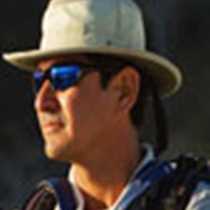Genovesa, otherwise known as Tower Island, is home to over one million seabirds. Our highlights here were diverse, from Nazca, red-footed & blue-footed boobies, to gulls and owls, fur seals, hammerheads sharks, turtles and manta rays.
Our adventure began with an early walk for photographers, with a wet landing on a white coralline beach inside Darwin Bay, named by a celebrity visitor, William Beebe, in honor of a great naturalist who re-directed human thought, Charles Darwin. We walked over a platform at low tide, surrounded by birds of all kinds with their chicks, observing their unique behavior and varied colors. We were moved by the attentive seabird parents, who were taking care of juveniles, hoping that one day they will be able to fend for themselves. We were also happy to find a few marine iguanas, which are smaller and darker on this island, as the northern hemisphere has a much different ecology, thus producing different results from what we have seen so far. When we reached our turning point, we were surprised by how quickly the tidal waters were changing; at high-tide, the ocean brought baby sting-rays, puffer fish, sea lions and many other creatures onto what had been our walking trail just a few minutes ago.
Today we had many, many options, from early walks to kayak, snorkeling from deep sea to the beach, long and fast walks, short walks, combinations of two activities, and much more, all before lunch!
On our final snorkeling outing of the expedition, we had close encounters with many fish and playful sea lions for the last time—seeing them up close inspired excitement and admiration. Some of us opted for beach snorkeling, which became a bit rough, for it seems that the seasons are changing earlier than expected.
After this great adventure, we came back to our ship anchored inside Genovesa caldera to be briefed about our departure and enjoy our last delicious lunch, the pride of our culinary staff.
After lunch, we opted for our last kayak outing and then a fast walk, while some relaxed on the beach or hiked to a nearby cliff. We were then ready to start off on our next adventure, at Prince Philip’s Steps, where we were surrounded by Nazca boobies, red-footed boobies and frigatebirds. We were even fortunate enough to spot the elusive short-ear owl! All of us felt rewarded to have a unique view of this unique bird, the only camouflaged diurnal raptor. Our guests were also able to spot humpback whales, an adult and a calf, along the horizon, as they leapt out of the water over and over again. We marveled at the majestic scene, the sun setting softly while the breeze kept us aware of the peacefulness of this place.
Taking this walk was like being transported back in time. There were birds flying all over, like in prehistoric times, and lava formations resembling the first foundations of Earth. Later, it was time to return to the ship and reminisce about the many experiences of such a wonderful week. As we look back and gaze at the islands for the last time, this place now seems timeless to us. It is now deep within our hearts, and our experience has been unforgettable on these special islands, where the wildlife that has no fear and allows us to realize that we are not so different from them.
“We must not acknowledge the methodical saying ‘don’t humanize the animals’ but instead ‘animalize the human’ by perceiving our surrounding with all our senses; embracing nature by coexistence and respect for one another, so we can become one with nature as we once were.” Celso Montalvo.
We have all bonded like a family, united by this invisible mysticism At the end of our journey, we hope to stay in touch, and we hope that the experience our guests had this week will stay with them for a lifetime.
Adiós amigos.







